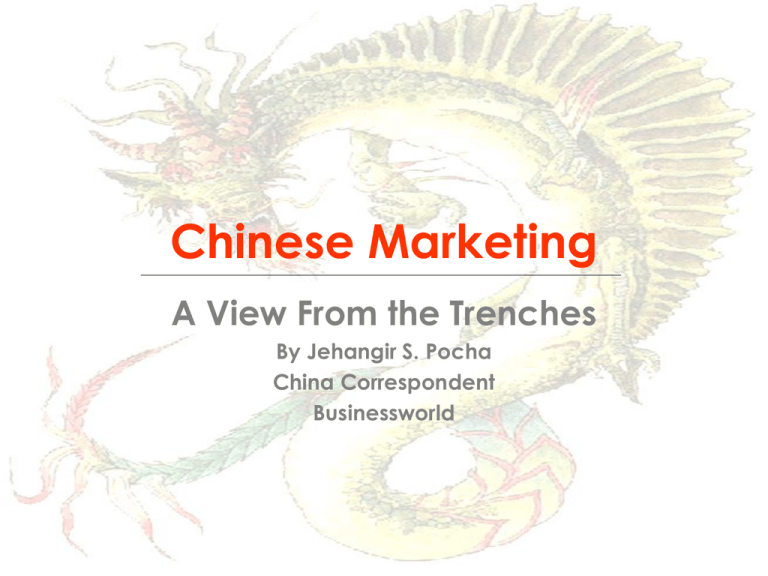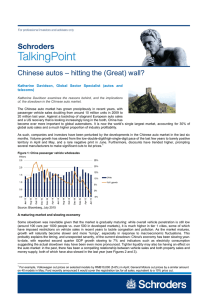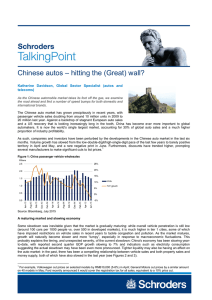China brands
advertisement

Chinese Marketing A View From the Trenches By Jehangir S. Pocha China Correspondent Businessworld A Google search for “China brands” returned: “China brands Taiwanese PM Chen Shui Bian a ‘troublemaker’”. – How has a country with such a negative world image acquired such a positive economic image? • By thinking big – and succeeding – While India has been debating how to attract buyers from Wal-Mart, China Entrepreneur magazine recently devoted a cover story to the question, "Should China Buy Wal-Mart?" • India leads China in terms of having a real private sector. • But India’s private sector has been inwardly focused, while China’s has been outwardly oriented. • China’s reforms aimed at attracting FDI • The entire country has a Western, modern orientation. • For Chinese companies the primary customer was always overseas: – Domestic consumption is low (35% of total consumption) – Export oriented incentives (export rebates are biggest expenditure item in budget) – Cheap capital allowed rapid creation and largescale enterprises The Result (Domestically) • In 1980, there were really no brands in China, domestic or foreign. • In 2000, the top-10 brands in China were American. • In 2005, of China’s top five brands only one was American – Coke. • Now, almost all these brands have their eyes set on the overseas markets. Best Brands • • • • • • • • • • • • • • • • CIMC – China International Marine Containers (state-owned) China Ocean shipping - COSCO - (state-owned) Geely Cars Wangxiang Qianchao – automotive parts – Sundaram Fasteners FAW cars (state-owned) Broad - Air conditioners Bird Mobile phones Li-Ning clothing/shoes YongHe fast food Wahaha GOME – electronic sales/retail Tong Ren Tang Technologies – Medicines (Tiger Balm type) Beijing Yanjing brewery Peal River pianos Shanghai Zhenhua Port machinery Group – cranes (state-owned) North China Pharma Group - 25 % rev. from exports to US, Japan. (Penicillin, vitamins) • Massive FDI factories and suppliers quickly taught Chinese companies how to create world-class products, with world-class finishing. • China’s workmanship is superior to India’s because of – primary education – work ethic – language • Active participation of Taiwanese, Hong Kong, SE Asian and Western Chinese diaspora, who were already plugged into foreign markets. • THINKING BIG – Soviet-era gigantism still infects official thinking and has diffused throughout the country. • Yet China, which is an industrial behemoth, functions like a “start-up country”, while India which functions on a “start-up” scale functions like an old-school conglomerate China’s adage • Don’t be afraid or too proud to bootstrap. • Learn to deal with “Status Deprivation” – Tatas may be big boys at home with a culture of comfort and dignity etc. But that might be an impediment to succeeding in new markets where you need to be scrappy and/or innovate. How do you nurture both cultures? (Employees, delegation, etc.) • Leave aside textbook stuff. To win a game the minimum requirement is to play it. – The minimum requirement of marketing is: • To know what customer wants. • To be able to deliver that in good time in a good way. • Start with what you have got. – If you have scale, start with it (Haier, TCL). – If you have cheap capital, use it (Lenovo/IBM and TCL/Thomson & RCA. • But you must learn to continually adapt and innovate and move up the value chain. • Those who do will survive, others will die. • In the 1990s China’s lumbering State Owned Enterprises were an “unsolvable” problem – Haier was one of those enterprises. – Haier is now the largest home-appliances manufacturer in China- and its most valuable brand. – $380 million of its $9 billion in sales comes from the U.S. where it claims a 50% market share in compact refrigerators and an 11% share in freezers. – Moral of the story: There is no “right way”; there is only the way that is right for you. • China has incredibly low learning curves – The country has become so sophisticated so quickly. • Chinese names used to be very culture specific, Flying Fish typewriters, and Double Happiness Bedding. • Even restaurants such as Southern Beauty win design awards. – The advantage of not speaking English • Language issue improves social mobility. Activist government • Pride should not prejudice our judgment of China – The biggest difference between China and India is not systemic, its attitudinal • Govt. engaged in building businesses & providing social services – – – – education, skills, policies, etc. providing cheap capital. Invisible support (contracts etc.) Engaging with thought leaders. • For example, the One Club, the international organization of advertising professionals, has been holding advertising seminars in China for the past four years. Free-market Fundamentalism • 1997 : “One country, Two Systems” – Hong Kong – China • 2006 : “One country, Three Systems” – Hong Kong – Capitalist industry and services – Socialist agriculture • All is not well. Like in India, local Chinese brands are losing out to foreign brands – In 2003, in a Sinomonitor monitor of 27 product categories, Chinese brands led in 16 (incl. Lenovo, Huiyuan juice, Peony bank cards). – In 2004, several domestic brands were replaced by foreign brands. – For example, Liushen shower gel and Dabao skin care products were ousted by P&G's Olay brand in both segments. Why? • Foreign companies have deeper systems and see value in “soft’ expenditures. – Last year, CCTV auctioned its prime time ad slots for a record sum of 5.3 billion yuan (US$634 million). – P&G spent more than 385 million yuan (US$46.5 million) at the auction and was the biggest bidder. • Foreign products enjoy much greater brand loyalty than their domestic rivals. • Consumption patterns are moving upscale. (Lancôme and Revlon reported sales growth rates of more than 90 percent). "The country's economic growth in the next 20 years will depend on domestic brand building." - Li Guangdou, general manager of Beijing Huasheng Shidai Advertisement Co. • And China still has a long way to go – The country currently has 2 million registered trademarks- just one brand for every six registered companies. – And foreign-funded companies own fully a quarter of those 2 million. • Biggest problem: Increasing professionalism and adjusting marketing strategies. – Often, successes in the domestic market are mainly based on the sheer size of the market and relatively low labor costs. E.g. Nokia. Can Indian and Chinese companies really develop the culture of creativity, innovation, calculated risk and professionalism that Western and Japanese companies enjoy? The Choice • The next US or EU or the next Brazil and Argentina. – Infusion of capital and cheap labor will assure a middle rate of development – But to transcend that China’s and India’s economies will need real efficiencies, and innovations. – To do that requires real social change and emancipation, and far-reaching political improvements. – As Alvin Toffler writes in his new book Revolutionary Wealth, advanced economies need advanced societies.








